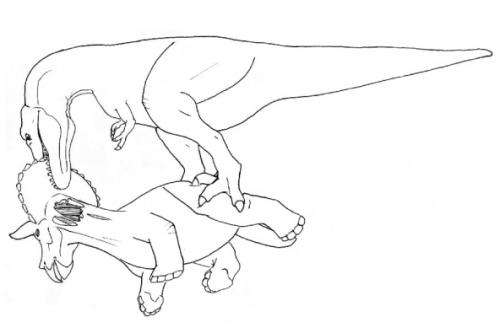October 29, 2012 report
Life, and death, of Triceratops: Fossilized tooth marks shed light on T.Rex's gruesome hunting practices

(Phys.org)—Paleontologist Denver Fowler has told a group of attendees at the Society of Vertebrate Paleontology's annual meeting that he, along with colleagues from the Museum of the Rockies, has uncovered evidence that suggests Tyrannosaurus Rex pulled the head off Triceratops victims to allow access to nutritious neck meat.
Scientists have for years believed that T.Rex, killed and ate Triceratops. But until now, most research has focused on the body of the Triceratops. In this new study, Fowler et al. concentrated on bite marks found on the skulls of 18 fossil specimens found in Montana's Hell Creek Formation.
None of the bite marks showed any signs of healing, suggesting they occurred after the animals' deaths. Initially, the researchers couldn't explain why a predator such as a Tyrannosaurus would bother with a skull, as there wasn't much to eat in that that area. But upon further review, the researchers discovered deep parallel grooves in the bone indicating that an animal had been pulling on it, with its teeth sliding along the bone's surface.
Triceratops had a large bony frill around the back of the skull to protect the sensitive neck and throat. The researchers believe that after killing its victim, Tyrannosaurus would pull on the frill until the head came off, allowing easy access to the large, meaty neck muscles.
In addition to the parallel groves, the researchers also noted bite marks on the ball socket joints that allowed the Triceratops to move its head around—marks that could only come about if the head were removed.
Fowler also said the team had found evidence of facial nibbling by Tyrannosaurus on the skulls of the Triceratops, indicating the dinosaur had a taste for the more delicate meat found there. That finding led the researchers to wonder if T.Rex ate in different ways as it grew older. Adults with thick teeth would have been able to tear the head off of a Triceratops, whereas younger T.Rex might have been satisfied with nibbling on softer, easier access points, thereby preserving their less-developed teeth. Fowler added that he and his colleagues plan to continue their investigation before submitting the present findings for publication.
More information: www.denverfowler.com/publicati … owler_et_al_2012.htm
© 2012 Phys.org


















